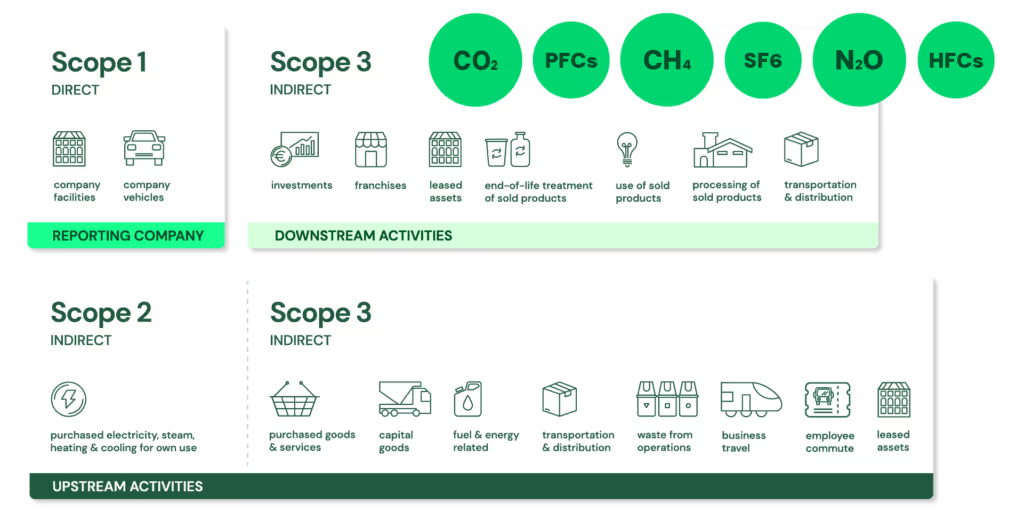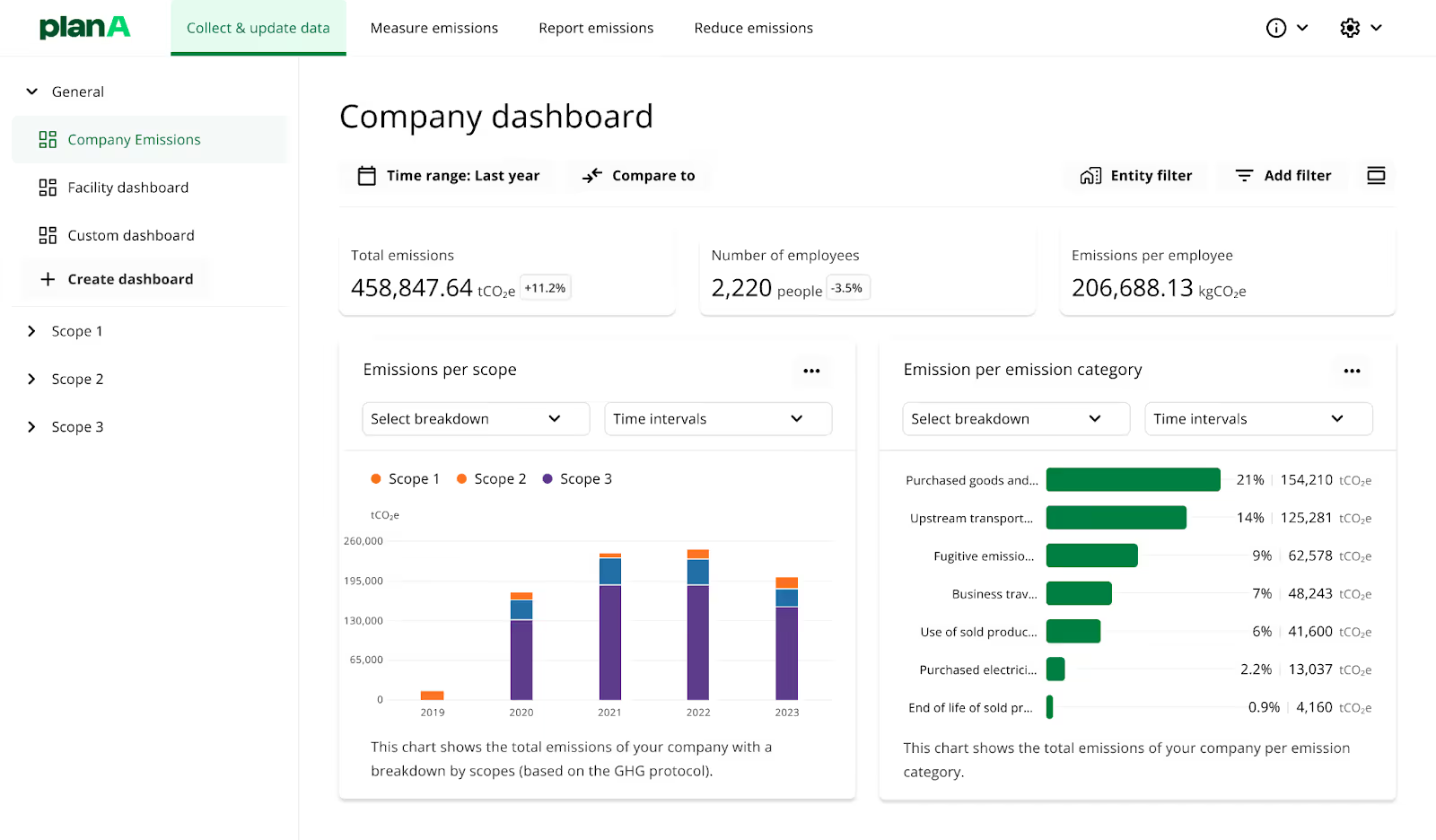Carbon accounting is all about taking responsibility for our businesses' impact on the planet. It means that it’s not just about numbers on a spreadsheet; it’s about understanding where our greenhouse gas (GHG) emissions come from and how to reduce them.
This process is non-negotiable for companies serious about sustainability, but getting it right requires more than good intentions, as it demands absolute accuracy. Thanks to the right emission factors, you can translate your everyday activities, like energy use or transport, into measurable emissions. Then, using them correctly makes it easier to calculate your company’s carbon footprint with precision, develop targeted strategies, and make data-driven decisions that will truly make a difference.
The definition of carbon emission factors
Carbon emission factors are essential for any business aiming to reduce its environmental impact. They tell you exactly how much CO2 and other greenhouse gases your activities are pumping into the atmosphere.
Suppose your company takes the time to understand these numbers. In that case, you can make smarter decisions about your operations, energy use, and even supply chains, which is the first step towards cutting your carbon footprint.
What is an emission factor (EF)?
For instance, the UK's emission factor for electricity consumption was approximately 0.233 kg CO2eq per kWh in 2023.
An emission factor can be described as the link between a company's activities (using electricity, driving vehicles, manufacturing goods…, etc.) and the emissions these activities produce. This means that the central role of an emission factor is to quantify how much of a specific pollutant, such as CO2 or methane, is emitted per unit of activity.
Good to know: This could be per unit of energy used, per tonne of product manufactured, or per kilometre driven!
When emission factors are calculated, a company's everyday actions can be highlighted to evaluate its environmental impact, even if all GHGs don’t have the same influence on global warming. For instance, nitrous oxide (N2O) is 265-298 times more potent than CO2 over 100 years.
This is why GHG emissions are often measured in CO2 equivalents (CO2e), allowing an evaluation of the warming effect of different gases compared to CO2.
Examples of emission factors
If you need an example, you can think about a tech company looking to track and reduce its carbon footprint through its :
- Electricity consumption (Scope 2): The goal is to calculate emissions factors related to electricity use in offices, data centres, and any other facilities (CO2e emissions per kWh of electricity consumed);
- Employee commuting and business travel impact (Scope 3): Knowing that different modes of transportation can significantly contribute to a company’s carbon footprint (e.g., kg CO2e per kilometre travelled by car, train, or plane);
- Waste and end-of-life disposal (Scope 3): Other important elements to consider are waste generation, recycling, and disposal of electronic equipment and office waste.
To better understand your electricity consumption, the first thing to know is that for every kilowatt-hour (kWh) of electricity consumed, a specific amount of CO2 is emitted. This amount of CO2 emitted is variable regarding the energy mix of the region :
- In Europe, the average emission factor for natural gas is 0.244 kg of CO2 per kWh. This means that for every kWh of electricity generated using natural gas, 0.244 kilograms of CO2 are released into the atmosphere;
- In China, the average emission factor for electricity generation from natural gas is around 0.205 kg of CO2 per kWh (mainly because coal is still a significant part of the energy mix of the country);
- In Australia, this emission factor is around 0.205 kg of CO2 per kWh, with a mix of both older and more efficient plants;
- In the United States, the average emission factor is 0.181 kg of CO2 per kWh, thanks to the higher efficiency of some power plants and the energy mix in the region.
Transport is another area where emission factors need to be calculated and interpreted. Knowing that an average petrol car in the UK has an emission factor of about 0.180 kg of CO2 per kilometre driven, companies can estimate their transport-related emissions by simply tracking the distance travelled by their vehicles. So, if a company’s fleet drives 10,000 kilometres in a year, it would emit approximately 1.8 tonnes of CO2. If the fleet drives 50,000 kilometres in a year, it will emit 9 tonnes of CO2, and so on.
What are the three scopes of carbon emissions?

Credit: Plan A
If you wonder what are Scopes 1, 2 and 3 of carbon emissions:
- Scope 1 includes direct emissions coming from company-owned and controlled resources and released into the atmosphere as a direct result of a set of activities at a firm level;
- Scope 2 includes owned indirect emissions coming from the generation of purchased energy from a utility provider;
- Scope 3 concerns not-owned indirect emissions, all of which occur in the company's value chain and are not included in Scope 2.
How are emission factors calculated?
Calculating emission factors is all about precision. It’s not just about knowing how much CO2 is emitted. It’s about understanding the complete picture: where those emissions come from, how they vary across activities, and what factors influence them.
What are the best methodologies for calculating emission factors?
Accuracy remains the main element to verify when calculating emission factors (EFs). The best methodologies blend empirical data collection with default factors directly provided by trusted regulatory agencies because they capture the specific conditions of a particular site or process. As a result, the accuracy obtained is due to the analysis of factors such as technology, efficiency, and, of course, operational practices of a given company.
The default factors are provided by what we call “regulatory agencies”, such as the Intergovernmental Panel on Climate Change (IPCC) and local environmental organisations. In practice, default factors represent averages from various data sources. Even if they are less specific, they provide a reliable baseline for many sectors, which makes them extremely valuable when direct measurements such as region-specific or sector-specific data are challenging to obtain.
Step-by-step guide to calculating emission factors
Here’s a step-by-step guide to accurately calculate emission factors:
- 1) Start by collecting all your emissions data: You will need to collect quantities or units of goods and services purchased or produced by your company, especially coming from data sources following recognised standards like the GHG Protocol;
- 2) Next, measure the actual emissions generated by your activities: Remember to include direct emissions data for Scope 1 but also indirect emissions from purchased energy data for Scope 2 to obtain precise emission factor calculations;
- 3) Convert these emissions into standard units: Then, you will need to apply global warming potential (GWP) values to convert different greenhouse gases (GHG) into their CO2 equivalents (CO2e). This step is more critical than it seems because it makes your data comparable while standardising this data across different reporting periods and units, both essential elements to be able to maintain accuracy over time;
- 4) Finally, calculate the emission factors by applying the appropriate formulas. This generally involves multiplying the activity data by the respective emission factors. Once calculated, you can compare these results to industry benchmarks or verified data from reliable sources to validate them and gain confidence in your final GHG inventory.
To lead the way in sustainability, your company needs clear and actionable insights from its data. This is where Plan A’s carbon accounting software can help you by simplifying the data collection process and offering you immediate visibility on your company’s carbon footprint. Ready to make a difference?
The role of international and national guidelines in standardising emission factors
Regarding international and national guidelines linked to emission factors, here are the two primary sources that you must know about:
These guidelines, taken together, will give any company a framework for measuring and reporting its emissions accurately.
The role of carbon accounting software in optimising emissions factors

Credit: Plan A
Carbon accounting software and emission factors in GHG calculations: How does it work?
If you wonder what carbon accounting software is, it’s a powerful tool to support businesses track, manage, and reduce their greenhouse gas emissions (GHG) with precision and ease.
Carbon accounting software takes the operational data your business already collects (like energy consumption or fuel use). It matches it with the relevant emission factors, which work as conversion rates, transforming your company’s activities into carbon emissions.
This automation is key. Why? It eliminates the manual treatment of the whole data, which reduces the risk of human error. At the same time, the software is regularly updated with the latest emission factors from trusted sources like the IPCC and the GHG Protocol, meaning that you have the guarantee that your calculations are always based on the most current data.
What are the key advantages of using carbon accounting software?
For business leaders and companies in general, carbon accounting software offers several key advantages such as:
- Automated data matching with emission factors: The software automatically aligns your operational data with the relevant emission factors, depending on the type and source of emissions. As a result, your GHG calculations are consistently accurate;
- Comprehensive and detailed data coverage: This kind of software also provides granular tracking across all emission sources within your company. It means that you will access a detailed view of your carbon footprint, from energy use to transportation;
- Up-to-date emission factors: One of the biggest challenges in manual carbon accounting is keeping track of the latest emission factors, while carbon accounting software regularly updates its emission factor databases automatically, with no need for manual updates.
Carbon accounting software: What are the benefits for companies with facilities in multiple countries?
If your company has facilities spread across multiple countries, carbon accounting software will be a powerful tool for managing the complexities of your numerous operations.
One of its main features is its ability to apply the correct emission factors based on location-specific data automatically. This means that whether your facility is in Europe, Asia, or North America, the software will ensure that the correct regional data is used, which involves local energy mixes, regulatory requirements, and even environmental conditions.
Your company’s interest here is in simplifying compliance with local regulations and obtaining a more accurate picture of your global carbon footprint.
Recommended features to look for in carbon accounting software
Finally, here is a list of some of our recommendations concerning the features to look for in the best carbon accounting software:
- GHG Protocol certification;
- Transparent methodologies and EF access;
- Multi-country data handling, with the automatic application of the right emission factors based on location-specific data;
- Regularly update the emission factors databases, following potential new scientific data and regulatory changes.
Ready to take carbon accounting to the next level? Schedule a call with our team.



.jpg)




